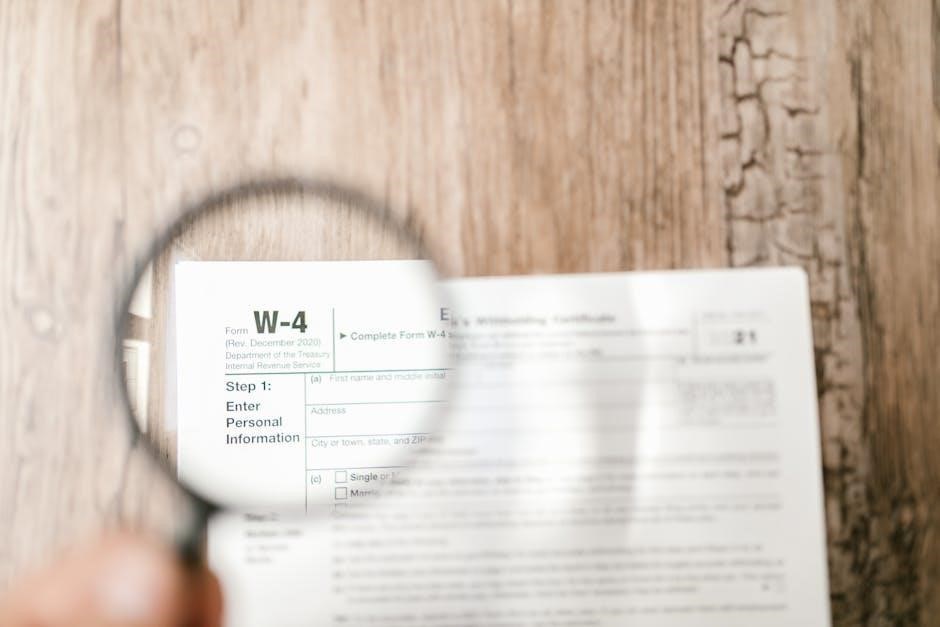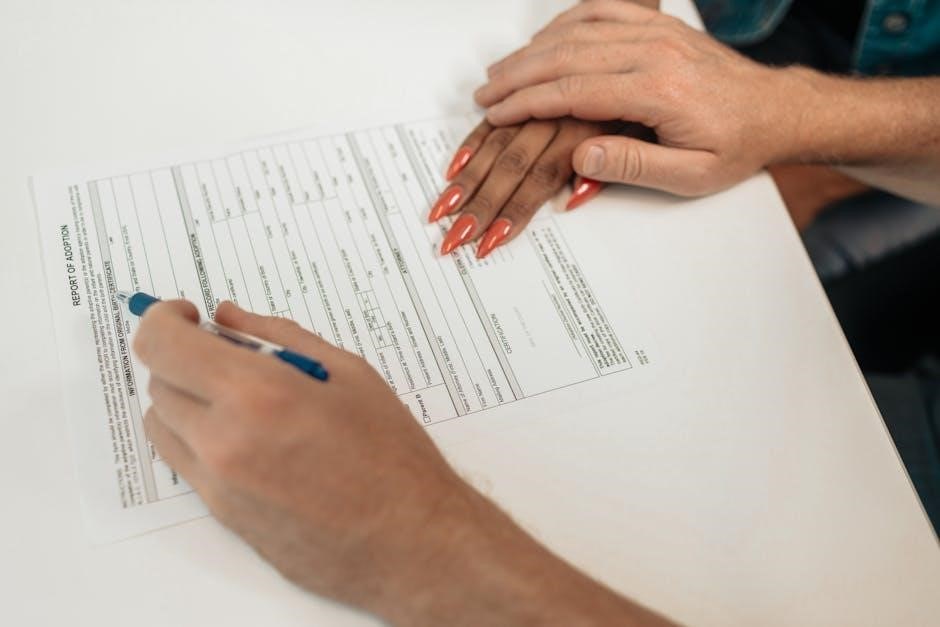The NHS Self-Certification Form is essential for employees to validate sickness absence up to 14 days. Download the PDF from official sources to ensure compliance with SSP requirements.
Overview of the Self-Certification Process
The self-certification process allows employees to confirm sickness absence without a doctor’s note for up to 14 days‚ including weekends. Employees can download the NHS Self-Certification Form (PDF) from official sources‚ complete it with details like absence dates and reasons‚ and submit it to their employer. This process streamlines sick leave verification‚ ensuring compliance with Statutory Sick Pay (SSP) requirements. Accurate information is crucial‚ as false claims may result in loss of benefits. The form is also valid for COVID-19 isolation periods‚ aligning with UK employment policies.
Importance of the Self-Certification Form
The NHS Self-Certification Form is vital for validating sickness absence‚ allowing employees to confirm their illness without a doctor’s note for up to 14 days. It simplifies the process for both employees and employers‚ ensuring compliance with Statutory Sick Pay (SSP) requirements. The form provides a clear record of absence‚ helping employers verify eligibility for sick pay. Its availability as a downloadable PDF makes it easily accessible‚ reducing administrative burdens and ensuring adherence to UK employment regulations. Accurate completion is essential to avoid penalties and maintain benefit entitlements.
What is the NHS Self-Certification Form?
The NHS Self-Certification Form is an official document used by employees to validate sickness absence up to 14 days‚ available as a downloadable PDF. It ensures compliance with SSP requirements and simplifies the process for employers.
Definition and Purpose of the Form
The NHS Self-Certification Form is an official document enabling employees to validate sickness absence up to 14 days‚ including COVID-19 isolation. Its primary purpose is to provide proof of illness for employers‚ supporting Statutory Sick Pay (SSP) claims. The form simplifies the process for employees to self-certify their absence without needing a doctor’s note initially. It ensures compliance with UK employment laws and streamlines sick leave verification for both employees and employers. The form is widely available as a downloadable PDF from official sources.
Key Features of the Self-Certification Form
The NHS Self-Certification Form is a straightforward document designed for employees to confirm sickness absence up to 14 days. It includes sections for personal details‚ absence dates‚ and a declaration of illness. The form is available as a downloadable PDF‚ ensuring easy access. It eliminates the need for a doctor’s note during the initial period‚ simplifying the process for employees. The form is essential for claiming Statutory Sick Pay (SSP) and ensures compliance with UK employment regulations‚ making it a convenient and legally compliant solution for sick leave verification.
Eligibility Criteria for Using the Form
The form is available for all employees requiring sick leave up to 14 days‚ including COVID-19 isolation‚ and can be downloaded as a PDF from official sources.
Who Can Use the Self-Certification Form?
The self-certification form is available for all employees needing to validate sickness absence up to 14 days‚ including periods of COVID-19 isolation. Employees do not require a doctor’s note for this duration. The form is accessible to individuals who are unable to work due to illness and need to inform their employer officially. It is widely used across various sectors‚ ensuring compliance with statutory sick pay (SSP) regulations. The PDF version can be downloaded from official NHS or employer websites for convenience.
When Should the Form Be Used?
The self-certification form should be used for periods of sickness absence up to 14 calendar days‚ including weekends and COVID-19 isolation. Employees must submit the form when they return to work to validate their absence. It is particularly useful for short-term illnesses where a doctor’s note is not required. Employers may request the form after seven days of sickness to verify eligibility for Statutory Sick Pay (SSP). The form ensures compliance with UK employment regulations and simplifies the process for both employees and employers.

How to Obtain the Self-Certification Form
Employees can download the NHS Self-Certification Form as a PDF from official sources or their employer’s website. Ensure the form is from a trusted provider for authenticity.
Downloading the Form from Official Sources
To ensure authenticity and compliance‚ employees should download the NHS Self-Certification Form directly from official sources‚ such as the NHS website or their employer’s official portal. The form is typically available in PDF format‚ making it easy to print and complete. Always verify the source to avoid using unapproved or outdated versions. Once downloaded‚ print the form‚ fill it in accurately‚ and submit it to your employer as required. This process ensures the form is valid and accepted for sick leave purposes.
Steps to Access the PDF Version
To access the NHS Self-Certification Form in PDF format‚ visit the official NHS website or your employer’s HR portal. Use the search bar to locate the SC2 Self-Certification Form. Click the download link to obtain the PDF. Ensure the document is from a verified source to avoid unauthorized versions. Once downloaded‚ print the form‚ complete it with accurate details‚ and submit it to your employer. This ensures compliance with sick leave procedures and SSP requirements.

Completing the Self-Certification Form
The form requires personal details‚ dates of absence‚ and the reason for sickness. Ensure accuracy and sign the declaration to confirm the information’s truthfulness.
Required Information and Fields
The form requires essential details such as the employee’s name‚ address‚ and employment information. It also includes fields for the dates of absence‚ the reason for sickness‚ and whether the absence is due to COVID-19 isolation. A declaration section is included for the employee to confirm the accuracy of the information provided. The form may also have a section for employer use‚ such as verifying the absence period. Ensure all fields are completed accurately to avoid delays in processing.
Guidelines for Filling Out the Form Accurately
Fill in all sections of the form truthfully and clearly‚ ensuring accurate dates and details about your sickness absence. Print your name and sign the declaration to confirm the information is correct. Avoid leaving fields blank‚ as this may delay processing. Provide clear reasoning for your absence‚ including COVID-19 isolation if applicable. Ensure the form is legible and completed in block capitals. Submit the form promptly to your employer to avoid any issues with SSP payments or record-keeping.

Submitting the Completed Form
Print‚ sign‚ and submit the completed form to your employer promptly; Ensure all sections are filled accurately to avoid delays in processing your sickness absence.
Where and How to Submit the Form
Once completed‚ print and sign the form. Submit it to your employer promptly‚ ensuring all details are accurate. Employers typically require the form to process sick pay claims. If your employer has specific submission guidelines‚ follow them carefully. Timely submission ensures compliance with SSP requirements and avoids delays in receiving statutory sick pay benefits.
Deadlines for Submission
Submit the completed form promptly to avoid delays in processing your sick pay. Employers typically require the form within 7 days of returning to work. Failure to meet deadlines may result in delayed SSP payments. Ensure timely submission to maintain eligibility for statutory sick pay benefits. Employers may have specific deadlines‚ so check their policies to comply accordingly.

Timeframe Covered by the Form
The form covers sickness absence up to 14 calendar days‚ including weekends and part days. Absences beyond 7 days typically require a doctor’s note for continued sick pay.
Duration of Sick Leave Covered
The NHS Self-Certification Form covers sickness absence for up to 14 calendar days‚ including weekends and part days. For absences exceeding 7 days‚ employees typically need a doctor’s note to continue receiving sick pay. This form simplifies the process for short-term illnesses‚ ensuring employees can validate their absence without immediately involving a healthcare provider. It’s essential to accurately state the duration to avoid delays in processing sick pay claims.
Extensions Beyond the Initial Period
If an employee’s sickness absence exceeds the initial 7-day period‚ they typically require a doctor’s note to extend their leave. The NHS Self-Certification Form covers absences up to 14 calendar days‚ but employers may request medical certification for longer periods. For absences beyond this‚ employees must transition to a medical certificate from their GP. This ensures continuity of sick pay and compliance with workplace policies. Extensions are not covered by the self-certification form alone‚ making timely medical verification essential for prolonged absences.

Medical Certification for Extended Absences
For absences exceeding 7 days‚ a doctor’s note is required to validate continued sick leave. This ensures the legitimacy of extended absences and prevents misuse of the system.
When a Doctor’s Note is Required
A doctor’s note is necessary for absences exceeding 7 days. Employees must provide medical certification to validate extended sick leave‚ ensuring compliance with employer policies and SSP regulations. This step prevents misuse of self-certification and confirms the legitimacy of prolonged absences. Failure to submit a doctor’s note may result in loss of sick pay benefits‚ emphasizing the importance of adhering to this requirement for absences beyond the initial 7-day period.
Transition from Self-Certification to Medical Certification
The transition from self-certification to medical certification occurs when an absence exceeds 7 days. Beyond this period‚ employees must obtain a doctor’s note to validate continued sick leave. This ensures compliance with employer policies and SSP regulations. The process involves submitting the medical certificate to the employer‚ replacing the initial self-certification form. This step is crucial for verifying the legitimacy of extended absences and maintaining eligibility for sick pay benefits. It also helps prevent misuse of the self-certification system‚ ensuring fair and consistent application of sick leave policies.
Accuracy and Truthfulness in the Form
Providing accurate and truthful information is crucial when completing the NHS Self-Certification Form. Misrepresentation can lead to loss of sick pay benefits and potential disciplinary action. Ensure all details are correct and truthful to maintain compliance with legal standards and employer policies.
Importance of Providing Correct Information
Providing accurate and truthful information on the NHS Self-Certification Form is essential to ensure compliance with legal standards and maintain trust between employees and employers. Misrepresentation can result in loss of sick pay benefits and potential disciplinary action. Employees must ensure all details‚ including the duration of sickness and reasons for absence‚ are correct to avoid complications. Honest disclosure is vital for fair assessment of sickness claims and adherence to SSP policies.
Consequences of Misrepresentation
Misrepresentation on the NHS Self-Certification Form can lead to severe penalties‚ including loss of sick pay benefits and potential disciplinary action. Providing false information violates trust and may result in withdrawal of SSP entitlement. Employers are legally entitled to investigate discrepancies and take action if fraud is suspected. Employees must ensure all details are truthful to avoid these serious consequences and maintain compliance with employment laws.
Statutory Sick Pay (SSP) and the Form
The NHS Self-Certification Form is crucial for claiming Statutory Sick Pay (SSP). Employees can download the PDF to validate sickness absence‚ ensuring employers can verify eligibility for SSP payments.
Link Between the Form and SSP Claims
The NHS Self-Certification Form is directly tied to Statutory Sick Pay (SSP) claims‚ serving as proof of sickness absence for up to 14 days. Employees can download the PDF to validate their eligibility‚ ensuring employers can process SSP payments accurately. This form streamlines the process‚ eliminating the need for a doctor’s note during the initial period‚ and helps employers verify the legitimacy of sick leave claims efficiently.
Role of Employers in Verifying the Form
Employers play a crucial role in verifying the NHS Self-Certification Form to ensure accuracy and legitimacy. They must review the form for completeness and truthfulness‚ confirming the absence details align with SSP eligibility criteria. Employers are responsible for maintaining records of the form and using it to process Statutory Sick Pay claims. They may also request additional evidence if discrepancies arise. This verification process ensures compliance with employment laws and protects both the employer and employee’s rights. Employers should guide employees on downloading and completing the PDF correctly.

Alternative Forms and Employer Policies
Some employers provide their own self-certification forms‚ but if unavailable‚ employees can download the standard PDF form. This ensures compliance with sickness absence policies and SSP requirements.
Using Employer-Specific Certification Forms
Many employers provide their own self-certification forms for sickness absence‚ tailored to company policies. These forms are often available on internal HR platforms or through direct requests. Employees should use their employer’s specific form if provided‚ as it ensures compliance with internal procedures. If an employer-specific form is not available‚ the standard NHS Self-Certification Form (PDF) can be used instead. Using the correct form is essential for processing sick pay and maintaining accurate records. Failure to use the appropriate form may delay payments or require additional documentation.
When the NHS Form is Not Available
If the NHS Self-Certification Form is unavailable‚ employees should first check if their employer provides an employer-specific certification form. Many companies offer tailored versions of the form‚ which can be accessed through HR departments or internal websites. If no alternative form is provided‚ employees may need to create a personal declaration stating the reason for absence and the duration. Always ensure compliance with employer policies and UK employment laws when submitting any form of certification. Consulting with HR is recommended for guidance.
Special Cases and Exceptions
The NHS Self-Certification Form addresses special cases‚ including COVID-19 isolation and other exceptional circumstances‚ providing necessary documentation for sickness absence beyond standard scenarios;
Self-Certification for COVID-19 Isolation
The NHS Self-Certification Form can be used for employees self-isolating due to COVID-19. It covers periods of up to 14 calendar days‚ including weekends‚ and does not require a doctor’s note. This provision simplifies the process for individuals adhering to public health guidelines during the pandemic. Employers accept this form as valid documentation for sickness absence related to COVID-19 isolation‚ ensuring compliance with UK employment policies.
Other Special Circumstances
The NHS Self-Certification Form also applies to other unique situations‚ such as bereavement or compassionate leave‚ where employees may need temporary absence. It covers sickness absences beyond COVID-19‚ including mental health-related leave or caring for a family member. The form is valid for up to 14 calendar days and does not require a doctor’s note‚ simplifying the process for employees during difficult times. It ensures compliance with SSP claims and supports employees during unforeseen personal circumstances.

Declaration and Signature
The declaration confirms the information provided is truthful. The employee’s signature validates the form‚ ensuring accuracy and compliance with legal requirements. False information may result in penalties.
Understanding the Declaration Statement
The declaration statement requires employees to confirm the accuracy of the information provided in the form. It is a crucial part of the NHS Self-Certification Form‚ ensuring honesty and accountability. By signing‚ employees affirm that their details are correct to the best of their knowledge. This section also serves as a reminder of the legal implications of providing false information‚ which can lead to penalties or loss of benefits. It’s essential to review the declaration carefully before signing to maintain compliance and trust between the employee and employer.
Significance of the Employee’s Signature
The employee’s signature on the NHS Self-Certification Form is a legal confirmation of the accuracy of the information provided. It ensures accountability and trust between the employee and employer. By signing‚ the employee acknowledges the truthfulness of their statements and accepts the consequences of any misrepresentation. This act also validates the form‚ making it an official document for sickness absence records. The signature is essential for maintaining integrity and compliance with employment policies and legal standards.

Legal and Compliance Aspects
The NHS Self-Certification Form is a legal document ensuring compliance with UK employment laws. It must be completed accurately to avoid penalties and maintain statutory entitlements.
Legal Implications of the Form
The NHS Self-Certification Form is a legal document that must be completed accurately. Providing false information can lead to loss of sick pay benefits and potential legal action. Employers are entitled to reject forms with errors or omissions. Misrepresentation can result in disciplinary measures‚ as the form is binding under UK employment law. Compliance with its requirements ensures adherence to statutory regulations and protects both employees and employers from legal disputes.
Compliance with UK Employment Laws
The NHS Self-Certification Form ensures adherence to UK employment laws‚ particularly regarding sick leave and pay entitlements. It aligns with the Statutory Sick Pay (SSP) scheme‚ which employers must follow. By completing the form accurately‚ employees and employers comply with legal requirements‚ avoiding potential disputes or penalties. The form’s design reflects the legal standards for validating sickness absence‚ ensuring fairness and consistency in its application across workplaces.

Quick Links and Resources
Access the SC2 Self-Certification Form via official sources like GOV.UK or NHS trust websites. Find additional guidance and support through practice leaflets and registration links.
Useful Websites for Downloading the Form
Visit official websites like GOV.UK or NHS trust portals to download the Self-Certification Form (PDF). Many employers and practices provide direct links‚ such as the SC2 form. Ensure you access the form from trusted sources to avoid errors or outdated versions. Additional resources‚ including practice leaflets and registration guides‚ are often available alongside the form. Always verify the website’s authenticity before downloading to maintain confidentiality and compliance with UK employment laws.
Additional Guidance and Support
For further assistance‚ visit GOV.UK or consult Citizens Advice for free support. Employers can provide SSP1 forms if sick pay is denied. Visit NHS trust websites for practice-specific guidance. If unsure about self-certification‚ contact HR or union representatives. Additional resources‚ such as FAQs and step-by-step guides‚ are available online. For complex cases‚ like COVID-19 isolation‚ refer to official UK government updates and NHS guidelines for clarity and compliance with current regulations.
The NHS Self-Certification Form simplifies sickness absence reporting. Download the PDF from official sources to ensure compliance with SSP requirements and avoid delays.
Final Tips for Using the Self-Certification Form
Always download the form from official sources to ensure accuracy. Fill in all required fields truthfully and check for errors before submission. Understand that the form covers up to 14 days of absence. If your absence exceeds seven days‚ be prepared to provide a doctor’s note. Double-check the submission deadlines and keep a copy for your records. Following these steps ensures compliance with SSP requirements and avoids delays in processing your sick leave.
The NHS Self-Certification Form is a crucial document for validating sickness absence up to 14 days. It is essential to download the form from official sources to ensure authenticity. Accurately complete all fields‚ as incorrect information may lead to delays or loss of benefits. The form is available as a PDF and must be submitted promptly to your employer. Ensure compliance with SSP guidelines and maintain a copy for personal records. This process simplifies the self-certification procedure‚ ensuring smooth processing of sick leave claims.
